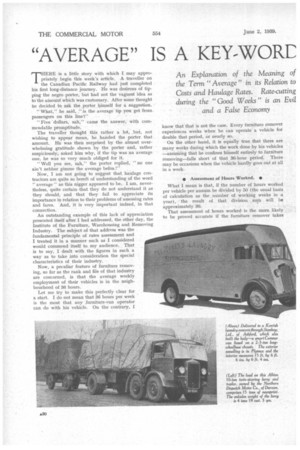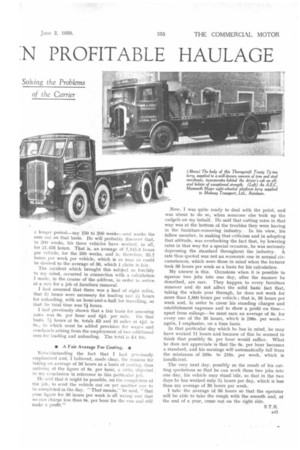"AVERAGE" IS A KEY-WORE N PROFITABLE HAULAGE
Page 32

Page 33

If you've noticed an error in this article please click here to report it so we can fix it.
An Explanation of the Meaning of the Term " Average " in its Relation to Costs and Haulage Rates. Rate-cutting during the "Good Weeks" is an Evil
and a False Economy
THERE is a little story with which I may appropriately begin this week's article. A traveller on the Canadian Pacific Railway had just completed his first long-distance journey. He was desirous of tipping the negro porter, but had not the vaguest idea as to the amount which was customary. After some thought he decided to ask the porter himself for a suggestion.
"What," he said, "is the average tip you get from passengers on this line?"
"Five dollars, sah," came the answer, with commendable promptitude.
The traveller thought this rather a lot, but, not wishing to appear mean, he handed the porter that amount. He was then surprised by the almost overwhelming gratitude shown by the porter and, rather suspiciously, asked him why, if the tip was an average one, he was so very much obliged for it.
"Well you see, sah," the porter replied, "no one ain't nebber gimme the average befoa!"
Now, I am not going to suggest that haulage contractors are quite so bereft of understanding of the word " average " as this nigger appeared to be. I am, nevertheless, quite certain that they do not understand it as they should, and that they fail to appreciate its importance in relation to their problems of assessing rates and fares. And, it is very important indeed, in that connection.
An outstanding example of this lack of appreciation presented itself after I had addressed, the other day, the Institute of the Furniture, Warehousing and Removing Industry. The subject of that address was the fundamental principle of rates assessment and I treated it in a manner such as I considered would commend itself to my audience. That is to say, I dealt with the figures in such a way as to take into consideration the special characteristics of their industry.
Now, a peculiar feature of furniture removing, so far as the rank and file of that industry are concerned, is that the average weekly employment of their vehicles is in the neighbourhood of 36 hours.
Let me try to make this perfectly clear for a start. I do not mean that 36 hours per week is the most that any furniture-van operator can do with his vehicle. On the contrary, I
know that that is not the case. Every furniture remover experiences weeks when he can operate a vehicle for double that period, or nearly so.
On the other hand, it is equally true that there are many weeks during which the work done by his vehicles —assuming that he confines himself entirely to furniture removing—falls short of that 36-hour period. There may be occasions when the vehicle hardly goes out at all in a week.
• Assessment of Hours Worked. • What I mean is that, if the number of hours worked per vehicle per annum be divided by 50 (the usual basis of calculation as the number of working weeks in a year), the result of that division sup will be approximately 36.
That assessment of hours worked is the more likely to be proved accurate if the furniture remover takes
a longer period—say 150 to 200 weeks—and works the sum out, on that basis. He will probably discover that, in 200 weeks, his three vehicles have worked, in all, for 21,436 hciurs. That is, an average of 7,145.3 hours per vehicle, for the 200 weeks, and is, therefore, 35.7 hours per week per vehicle, which is as near as could be desired to the average of 36, which I claim is fair.
The incident which brought this subject so forcibly to my mind, occurred in connection with a calculation I made, in the course of the address, in order to arrive at a rate for a job of furniture removal.
I had assumed that there was a lead of eight miles, that 3!, hours were necessary for loading and 21 hours for unloading, with an hour-and-a-half for travelling, so that the total time was 71hours.
I had previously shown that a fair basis for assessing rates was 8s. per hour and 41d. per mile. On that basis, 7i hours at 8s. totals 2.3 and 16 miles at 41d. is 6s., to which must be added provision for wages and overheads arising from the employment of two additional men for loading and unloading. The total is R.-I 16s.
• A Fair Average For Costing. •
Notwithstanding the fact that I had previously emphasized and, I believed, made clear, the reasons for taking an average of 36 hours as a basis of costing, thus arriving at the figure of 8s. per hour, a critic objected to my conclusion in reference to this particular job.
He said that it might be possible, on the completion of the job, to send the vehicle Out on yet another one to be completed in the day. "That means," he said, "that your figure for 36 hours per week is all wrong and that we can charge less than 8s. per hour for the van and still make a profit." Now, I was quite ready to deal with the point, and was about to do so, when someone else took up the cudgels on my behalf. He said that cutting rates in that way was at the bottom of the troubles they were having in the furniture-removing industry. In his view, his fellow member, in making that criticism and in adopting that attitude, was overlooking the fact that, by lowering rates in that way for a special occasion, he was seriously depressing the standard throughout the industry. A rate thus quoted was not an economic one in normal circumstances, which were those in mind when the lecturer took 36 hours per week as a basis for his calculation.
My answer is this. Occasions when it is possible to squeeze two jobs into one day, after the manner he described, are rare. They happen to every furniture remover and do not affect the solid basic fact that, taking the whole year through, he does not work for more than 1,800 hours per vehicle ; that is, 36 hours per week and, in order to cover his standing charges and establishment expenses and to show a profit on time— apart from mileage—he must earn an average of 8s. for every one of the 36 hours, which is 288s. per week— again, I emphasize, on a time basis.
In that particular day which he has in mind, he may have worked 11 hours and because of this he seemed to think that possibly 6s. per hour would suffice. What he does not appreciate is that the 6s. per hour becomes a standard, and his earnings will automatically fall from the minimum of 288s. to 216s. per week, which is insufficient.
The very next day, possibly as the result of his cutting quotations so that he can work these two jobs into one day, his vehicle may stand idle, so that in the two days he has worked only 51 hours per day, which is less than my average of 36 hours per week.
I take the average of 36 hours so that the operator will be able to take the rough with the smooth and, at the end of a year, come out on the right side.












































































